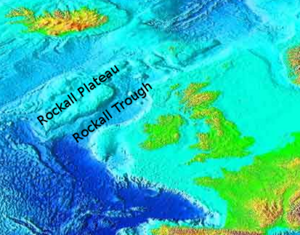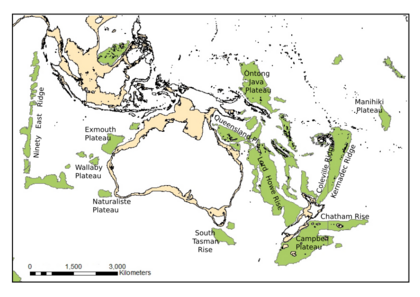Oceanic plateau facts for kids
An oceanic plateau (also called a submarine plateau) is a large, flat area on the ocean floor. It rises much higher than the seabed around it, often with steep sides. Think of it like a giant, flat-topped mountain hidden under the sea!
There are 184 known oceanic plateaus across the world's oceans. Together, they cover a huge area of about 18,486,600 km2 (7,137,700 sq mi), which is roughly 5% of all our oceans. The area around Australia and New Zealand in the South Pacific has the most oceanic plateaus.
These amazing underwater features form in a couple of main ways:
- Volcanic Plateaus: Many oceanic plateaus are created by massive volcanic eruptions, similar to huge floods of lava on land. These eruptions often happen over hotspots or mantle plumes, which are places where hot rock rises from deep inside Earth. Famous examples include the areas near volcanic islands like Iceland and Hawaii. The three biggest volcanic plateaus are the Caribbean, Ontong Java, and Mid-Pacific Mountains.
- Continental Plateaus: Other oceanic plateaus are actually pieces of continental crust that have broken off from continents. They were once part of a landmass but are now submerged. Examples include the Falkland Plateau and Lord Howe Rise.
Volcanic oceanic plateaus can rise 2 to 3 kilometers above the surrounding ocean floor. They are also more buoyant (they float better) than regular oceanic crust. This means they are less likely to be pulled down into the Earth's mantle when tectonic plates collide. Instead, they often "dock" or attach themselves to the edges of continents. This process helps continents grow larger over millions of years!
The formation of these large plateaus has also had a big impact on Earth's climate in the past. For instance, three huge oceanic plateaus formed during the Cretaceous period (a long time ago!) in the Pacific and Indian Oceans: Ontong Java, Kerguelen, and Caribbean.
Contents
How Oceanic Plateaus Help Build Continents
Geologists think that igneous oceanic plateaus are like important steps in how continental crust forms. Continental crust is the thick, lighter rock that makes up our landmasses. Oceanic crust is thinner and denser, found under the oceans.
Oceanic plateaus are special because they are less dense than regular oceanic crust, but still a bit denser than continental crust. This difference in density comes from the types of minerals and elements in the rocks, especially silicon.
- Rocks with lots of silicon are called felsic and are lighter (like those in continents).
- Rocks with less silicon are called mafic and are denser (like those in oceanic crust).
Oceanic plateaus have a mix, but they lean more towards mafic.
When an oceanic plate slides beneath another plate (a process called subduction), the rocks melt and create new volcanoes. If this happens under an oceanic plateau, the new volcanic eruptions produce rock that is lighter and has more silicon than the plateau itself. This new rock is more like continental crust!
Over millions of years, if this process continues, or if one oceanic plateau slides under another, even lighter, more continental-like crust can form. This shows how oceanic plateaus play a key role in slowly building up and growing our continents.
Where to Find Oceanic Plateaus
Oceanic plateaus are found in all the world's major oceans. The table below shows how they are spread out globally.
| Ocean | Area (km2) |
Plateau Area (%) |
Number of Plateaus |
Average Plateau Area (km2) |
|---|---|---|---|---|
| Arctic Ocean | 1,193,740 | 9.19 | 12 | 99,480 |
| Indian Ocean | 5,036,870 | 7.06 | 37 | 136,130 |
| North Atlantic Ocean | 1,628,360 | 3.64 | 36 | 45,230 |
| North Pacific Ocean | 1,856,790 | 2.26 | 33 | 56,270 |
| South Atlantic Ocean | 1,220,230 | 3.02 | 9 | 135,580 |
| South Pacific Ocean | 7,054,800 | 8.09 | 50 | 141,100 |
| Southern Ocean | 495,830 | 2.44 | 12 | 41,320 |
| World Ocean | 18,486,610 | 5.11 | 184 | 100,470 |

Examples of Continental Oceanic Plateaus
These plateaus are made of pieces of continental crust:
- Campbell Plateau (South Pacific)
- Challenger Plateau (South Pacific)
- Exmouth Plateau (Indian Ocean)
- Falkland Plateau (South Atlantic)
- Lord Howe Rise (South Pacific)
- Rockall Plateau (North Atlantic)
Examples of Igneous Oceanic Plateaus
These plateaus were formed by massive volcanic eruptions:
- Agulhas Plateau (Southwest Indian Ocean)
- Azores Plateau (North Atlantic)
- Broken Plateau (Indian Ocean)
- Caribbean-Colombian Plateau (Caribbean Sea)
- Exmouth Plateau (Indian Ocean)
- Hikurangi Plateau (Southwest Pacific)
- Iceland Plateau (North Atlantic)
- Kerguelen Plateau (Indian Ocean)
- Magellan Rise (Pacific Ocean)
- Manihiki Plateau (Southwest Pacific)
- Mascarene Plateau (Indian Ocean)
- Naturaliste Plateau (Indian Ocean)
- Ontong Java Plateau (Southwest Pacific)
- Shatsky Rise (North Pacific)
- Vøring Plateau (North Atlantic)
- Wrangellia Terrane (Northeast Pacific)
- Yermak Plateau (Arctic Ocean)
See also
- Abyssal plain
- Bathymetry
- Glossary of landforms
- Ocean bank


